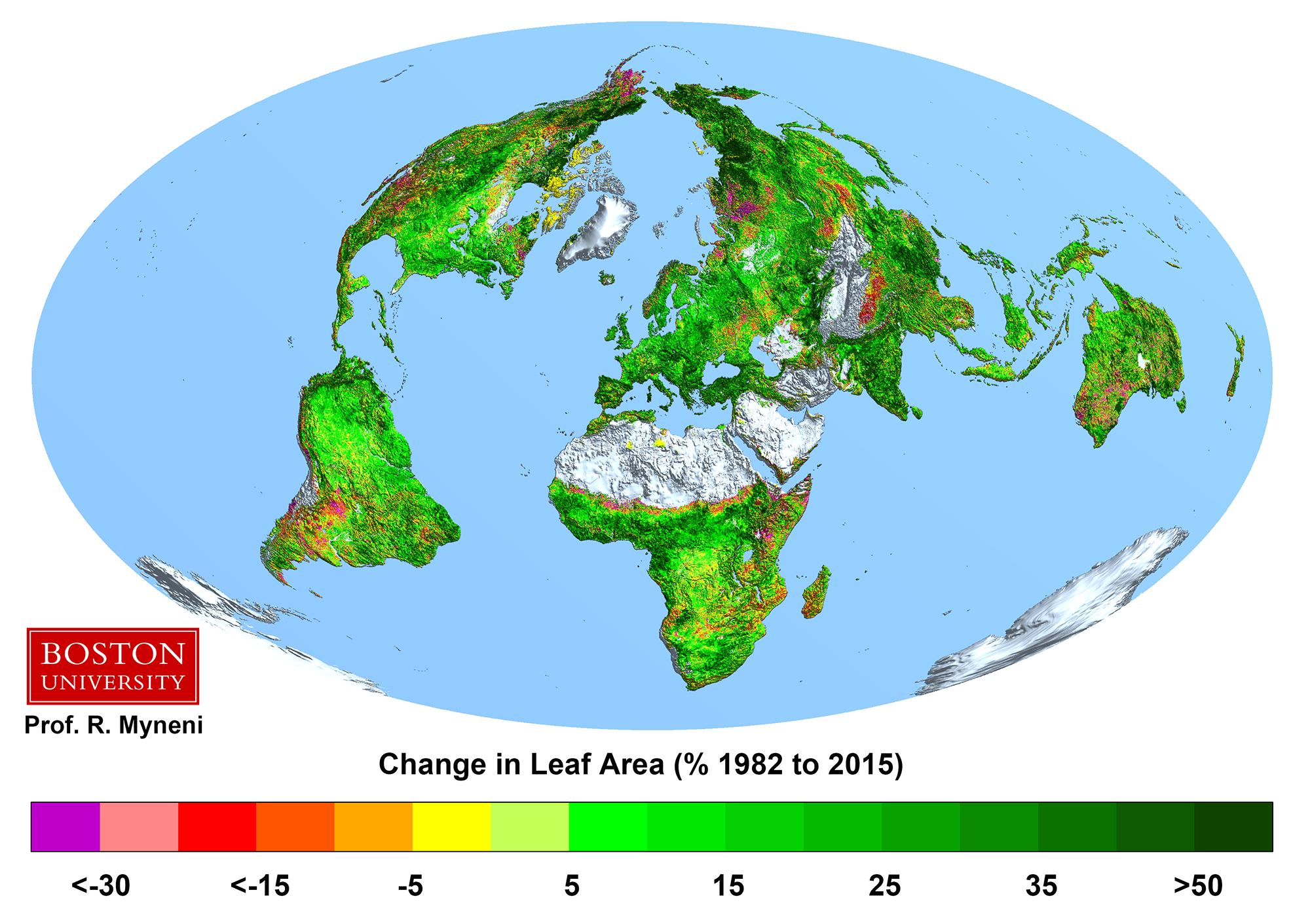
Rising CO2 has ‘greened’ world’s plants and trees
Roz Pidcock
04.25.16Earth’s plants and trees have sprouted enough new leaves since the early 1980s to cover twice the area of mainland United States, according to new research.
The paper, published today in Nature Climate Change, shows that up to half of the Earth’s vegetation-covered land is now “greener” than it was 30 years ago. Most of the change is down to rising CO2 from human activity, say the researchers.
But this shouldn’t automatically be taken as good news. Any benefits of “CO2 fertilisation” may be temporary and are outweighed by the negative consequences of climate change, such as extreme weather, sea level rise and ocean acidification.
Dr Tristan Quaife, an expert in satellite monitoring of plants at the University of Reading, who wasn’t involved in the new research, says the study is evidence of the huge impact humanity is having on the natural world. He tells Carbon Brief:
Greening planet
Scientists know concentrations of CO2 in the atmosphere are rising. But how the world’s plants and trees are responding has proven far trickier to pin down.
Dr Josep Canadell, a researcher at Australia’s Commonwealth Scientific and Industrial Research Organisation (CSIRO) and co-author on the new paper, tells Carbon Brief:
The new study uses observations from satellites, which can detect changes in land characteristics over time by measuring how light is reflected and absorbed by the Earth’s surface.
Using three different satellite records, spanning 1982-2009, the scientists find a “greening” trend across 25-50% of land covered by vegetation.
Europe, central Africa, southeast Asia, northern parts of the Amazon and the southeast corner of North America have seen the biggest changes, as the map below shows.

Change in leaf area in % from 1982-2015. Credit: R. Myneni.
The observed “greening” trend is a combination of new leaves sprouting on existing plant life, as well as an increase in the total amount of land covered by plants, shrubs and trees. Co-author on today’s study, Prof Ranga Myneni from Boston University, tells Carbon Brief:
Less than 4% of global vegetation showed a “browning effect” over the study period, he explains. Examples include northwest North America and central South America.
“Fingerprinting”
Once the authors had identified the size of the “greening” trend, they set about unravelling what has been driving it.
Using complex ecosystem models and a technique known as “fingerprinting”, the authors estimated that 70% of the extra green growth is down to rising CO2 in the atmosphere. Canadell explains:
Climate change-induced shifts in temperature and rainfall patterns are behind a further 8% of the global “greening” trend. This is true for high latitudes, the Tibetan Plateau and the Sahel region of sub-Saharan Africa, for example. In other areas, such as South America, such shifts are having negative consequences. The paper notes:
More nitrogen in the soil, partly a result of fertiliser use, as well as changes in forest cover, grazing and intensive farming have also contributed to the “greening” trend, the study explains.
Not necessarily news
The fact that rising CO2 can lead to “greening” of the world’s vegetation isn’t a new discovery. Scientists have known about this for decades, Canadell tells Carbon Brief:
The reason today’s study is significant is because it shows the CO2 fertilisation effect in action globally and over the whole satellite record, he explains.
Projects such as the Free Air Enrichment Experiments (FACE) have been instrumental in showing “greening” in individual locations. Quaife tells Carbon Brief:
In a guest post for Carbon Brief, Prof Richard Betts, head of climate impacts research at the Met Office Hadley Centre, explains more about the FACE experiments and the challenges of measuring the real-world effects of CO2 fertilisation.
“Warning light”
The authors of today’s study stress that the trend towards global greening over the past 30 years is not evidence that climate change is beneficial. Myneni tells Carbon Brief:
Plants and trees currently remove about a quarter of anthropogenic CO2 emissions, slowing the pace of climate change. But Quaife tells Carbon Brief:
Scientists can’t be sure how long vegetation will keep pace with our emissions, Quaife adds. As CO2 concentrations increase, other factors such as the availability of nutrients may well limit growth, he explains.
Importantly, any argument that uses global “greening” to suggest climate change is beneficial ignores the many negative consequences. Canadell tells Carbon Brief:
Combined with the decline of pollinators and increased exposure to pests and pathogens, the risks posed by extreme weather are likely to reduce global crop yields far more than CO2 fertilisation is likely to increase them, says Prof Samuel Myers, senior researcher in the Department of Environmental Health at Harvard University.
Myers tells Carbon Brief:
His research also highlights what he calls “darker side” of the impact of rising CO2 concentrations on food production. He explains:
With roughly two billion people around the world suffering from dietary deficiencies of iron and zinc, less of these nutrients in basic food crops would represent an urgent public health threat, says Myers.
Rather than being taken automatically as good or bad news, thinking about CO2 fertilisation in the wider context of ongoing climate change is crucial.
The sheer scale of the global greening trend should serve as a stark reminder of how human activity is affecting the planet’s ecosystems, Canadell concludes:
Main image: Raindrops on leaf, Oahu, Hawaii, USA. © Motomu Takayama/Aflo/Corbis.
Zhu, Z. et al., (2016) Greening of the Earth and its drivers. Nature Climate Change doi: 10.1038/nclimate3004.
-
Rising CO2 has 'greened' world's plants and trees
-
Earth's plants and trees have sprouted enough new leaves since the early 1980s to cover twice the area of mainland United States, says news research

